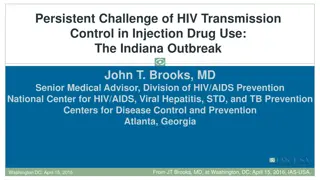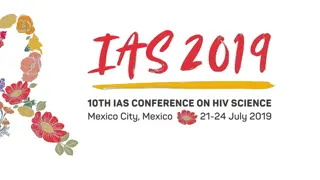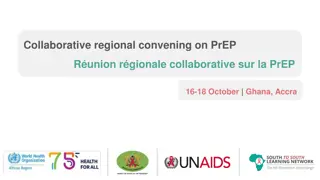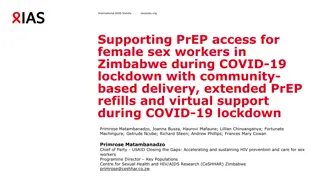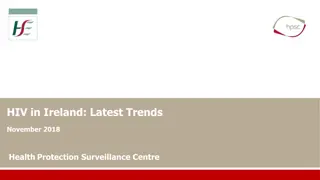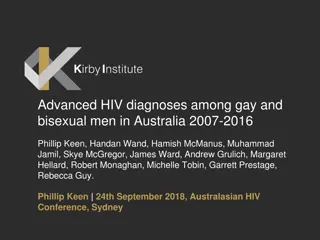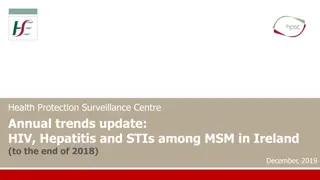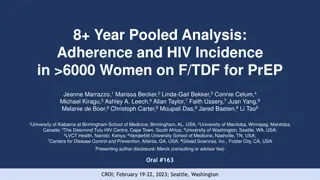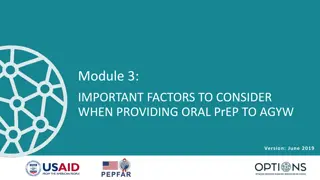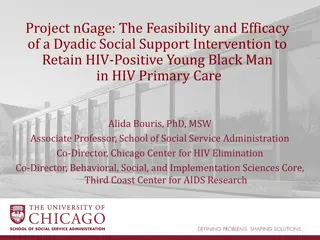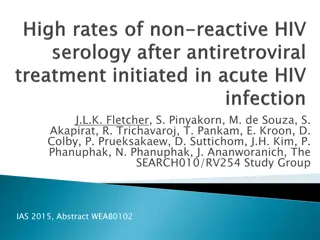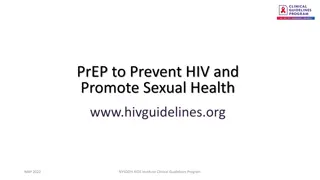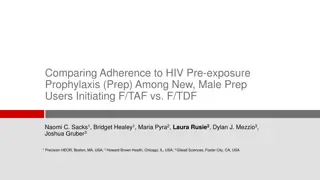Exploring the Use of PrEP to Reduce HIV Transmission Among African American Men
In response to the HIV/AIDS pandemic, this study focuses on the effectiveness of Pre-Exposure Prophylaxis (PrEP) in reducing HIV transmission among African American men who have sex with men in Orangeburg, SC. The research aims to investigate the impact of PrEP compared to condom use, and the necessity of PrEP when the partner is already HIV positive. Through detailed experimental design and analysis, the study seeks to contribute valuable insights to HIV prevention strategies.
Download Presentation

Please find below an Image/Link to download the presentation.
The content on the website is provided AS IS for your information and personal use only. It may not be sold, licensed, or shared on other websites without obtaining consent from the author. Download presentation by click this link. If you encounter any issues during the download, it is possible that the publisher has removed the file from their server.
E N D
Presentation Transcript
Jasmine Love Use of PrEP to reduce transmission of HIV among African American men that sleep with men.
Introduction In the spring of 1981, reports of the first cases of acquired immunodeficiency syndrome (AIDS) were made in the US. The virus that causes AIDS, known as the human immunodeficiency virus (HIV), was discovered by 1983. Substance addiction was found to play a strong role in the transmission of AIDS early in the U.S. HIV/AIDS pandemic. It has been determined that injectable drug users' injection drug use (IDU) is a direct pathway for HIV infection and transmission. Men who have sex with men (MSMs), are gay and bisexual males who made up most of the early AIDS cases. The bulk of early HIV infections that were sexually transmitted were in urban, educated, white people, and were frequently linked to alcohol and other drug use.
Specific Aims The proposed experiment will investigate the use of PrEPto reduce the transmission of HIV among African American men that sex with other men in Orangeburg, SC. The study will also investigate if condoms are more effective at preventing HIV than PrEP, and if it is necessary to use PrEPif the individual s sex partner is also HIV positive. Aim #1: Submit an IRB application for the use of PrEPto reduce HIV transmission. Aim #2: Conduct a study for HIV-positive men who have sex with men (MSM) after receiving approval. Aim #3: Provide the participants with the 28 day treatment of PrEPthat will be used to reduce their risk of transmitting HIV.
Experimental Design Cutrell, A. et al. performed a meta-regression of data from FEM-PrEP,12 VOICE,11 iPrEX,6 Bangkok,14 Partners PrEP,10 TDF2 (Botswana),13 and Ipergay in order to start estimating the NI margin for the likely comparator for many future investigations of PrEP.8. The absence of a matching adherence measure prevented the PROUD research results7 from being incorporated into the model. Tenofovir plasma concentrations were measured to measure adherence; however, different trials had different thresholds for determining adherence. Most trials employed a threshold of 0.31 ng/mL, while threshold values varied from 0.1 to 10 ng/mL. The trial-level adherence and TDF/FTC efficacy were found to be clearly and consistently correlated (Figure 2). With respect to sex and a predetermined degree of adherence, the meta-analysis permits the determination of the observed (RR estimate) and demonstrated (RR upper bound) effect of TDF/FTC. Assuming 45%, 65%, and 85% adherence rates, Table 1 presents estimates of the demonstrated effect for men and women along with possible margins of error. Comparing TDF/FTC to NPI, there is a slight but notable improvement in adherence of 45% (shown effects of 0.98 and 0.96 in men and women, respectively). As adherence rises, TDF/FTC's proven impact also rises. The resulting M2 margins obtained from these estimated impacts are likewise displayed in the table. Since NI studies require around 100,000 HIV infections, they are obviously impracticable given the lowest levels of adherence and similarity among treatment efficacies.
Significance The scientific significance of this proposal is to help people who have been impacted by HIV. This is important because it can serve as a guide to future researchers on not only preventing HIV, but also possibly finding a cure for those who are already suffering from this disease. In future endeavors with this virus, researchers can develop long-acting treatments that may be given once a week, once a month, or even less frequently than the existing antiretrovirals, which require daily administration. These long-acting treatments may also be less hazardous and more economical than taking tablets every day, and they may be simpler for certain people to adhere to. If my hypothesis is proven true, there will be a big breakthrough in science, causing millions of people to be cured of a disease that was once looked at as a death sentence. If my hypothesis was proven to be false, there will be more research provided to those who wish to continue this research. More trial and error, which could help science get closer to the cure.









